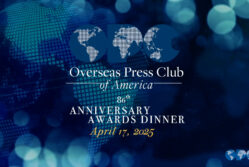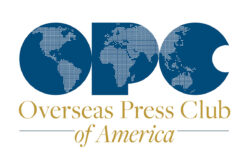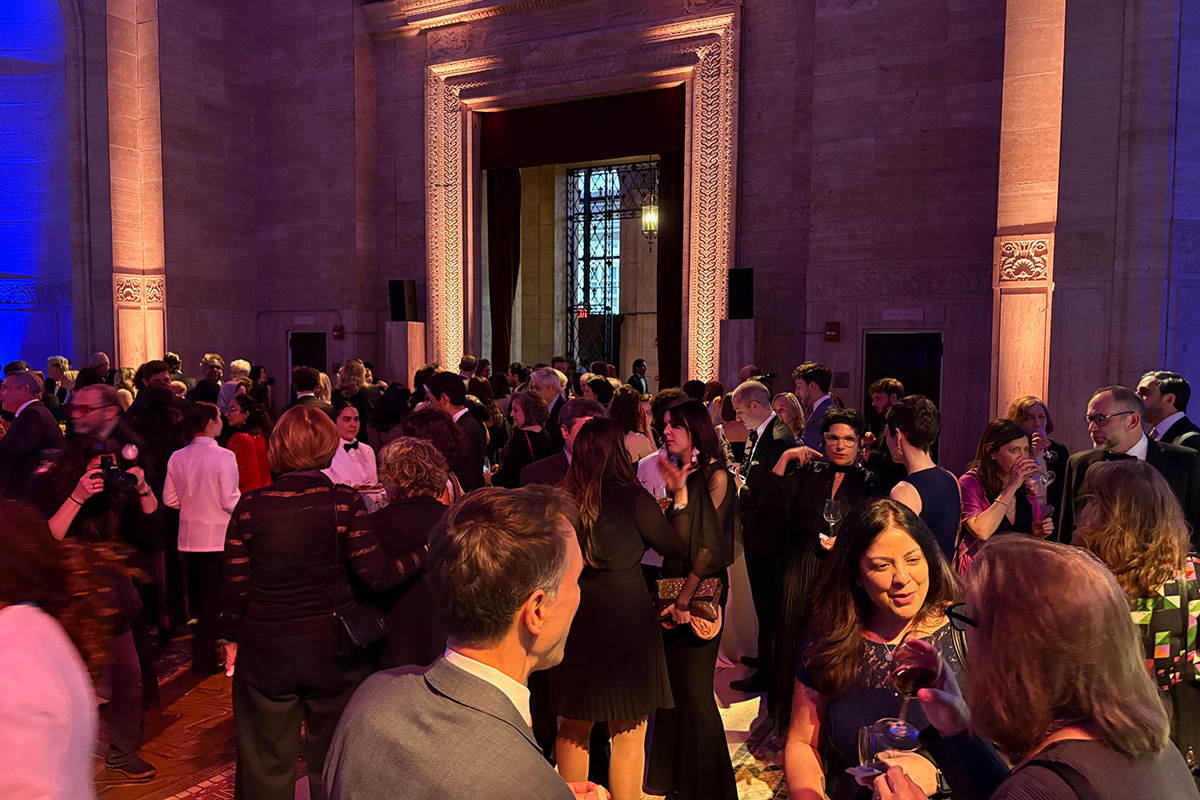Event Coverage Highlight

Overseas Press Club Annual Awards Dinner Honors Exceptional Reporting and Highlights Rising Threats to Journalists
by Jack Stone Truitt
International correspondents and their colleagues gathered in New York City on April 17 for the Overseas Press Club of America’s 86th Annual Awards Dinner to honor exceptional journalism from one of the deadliest years on record for members of the press. In his opening remarks, OPC President Scott Kraft said unprecedented attacks on the First Amendment in the U.S. chillingly echoed the challenges faced by many journalists in reporting on authoritarian regimes abroad.
“We have often gathered for these awards against a backdrop of crisis, and tonight is no different,” Kraft said. “Press freedom is under threat, as we all know. Governments are trying to manipulate and silence us. Our colleagues are targeted, harassed, and intimidated. And, for the first time in memory, we face many of those same threats at home.”
Like many in attendance, keynote speaker and New York Times columnist Nicholas Kristof has a deep well of experience reporting under the thumb of authoritarian governments. He reflected on what might be gleaned from reporting on people who live under regimes that do not have the same kind of freedoms enjoyed in the U.S.
“Precisely because they did not enjoy those rights, they understood even more than we do, perhaps, the value of them to a free society. And I’ve come to think we can learn an awful lot from those folks who risked their lives for democracy, whether in Beijing or in Egypt and so many other places around the world,” he said.
Kristof also gave a nod toward what can be learned from this year’s award winners, many of whom had to operate in environments hostile to their work. “If they can stand unflinchingly for these freedoms, then so can we all,” he said.
Attacks on the press by authoritarian leaders reflect how valuable its work truly is, he said.
“Our fidelity has to be utterly to the truth as we understand it,” he said. “We fail in that responsibility if we dispassionately observe our way to authoritarianism, and we shouldn’t be neutral about upholding democracy,” he said.
He closed his remarks underscoring the opportunity the press finds itself in, calling it a privilege to cover the U.S. at a potential turning point in its history.
“If we stick to our principles, if we’re ‘not at war, but at work,’ if we follow our compass as best we can, if we’re humble enough to acknowledge all our imperfections, that we get it wrong regularly, if we acknowledge all that, then we will get through this,” he said.
Kristof’s remarks opened by celebrating the work of The Associated Press in pushing back against the Trump administration’s efforts to limit its access in covering the White House, as well as the release and return last year of Wall Street Journal reporter Evan Gershkovich after 491 days of Russian detainment.
The OPC continued its tradition of lighting the Press Freedom Candle honoring journalists who have been killed, injured or imprisoned in the past year. Charles Forelle, deputy editor of The Wall Street Journal, spoke about last year’s release of Gershkovich.
“Never have we been quite so happy to see a name move from a headline to a byline as Evan’s did when he appeared in our pages again,” he said. But he also noted the 361 journalists who remained imprisoned as of December of last year, according to the Committee to Protect Journalists (CPJ).
“This work isn’t over. There are many, many, many, many more stories to tell, and the people in this room will tell them,” he said.
Gershkovich’s return was a bright spot in a year otherwise marred by an increased number of reporters and other media members killed in the line of their work. At least 124 journalists and other members of the media were killed in 2024, nearly two-thirds of whom were Palestinian media members killed in Gaza, according to the CPJ. This toll was the highest ever recorded by the CPJ since it began tallying such data in 1992.
Associated Press Executive Editor Julie Pace lighted Press Freedom Candle.
“We know what it’s like for journalists to work in places where the protections of a First Amendment don’t exist, to work in countries where the consequences of resisting government pressure are even greater. It’s not just access that they risk losing in those places, it’s their physical safety,” Pace said, underscoring the weight the AP felt in standing up against the White House’s attempt to revoke its access to the president.
“As the dangers to journalists around the world grow, it’s more important than ever that we here rally together to uphold the protections afforded to the press in the United States,” she said.
This year’s OPC President’s Award went to photojournalist Lynsey Addario, whose work has focused on humanitarian issues, particularly those faced by women, ranging from Afghanistan, the Congo, Haiti, and the ongoing war in Ukraine.
Addario dedicated her award to local journalists and staff on the ground who make the work of foreign correspondents possible, while putting out important work at the risk of dire consequences often not faced by foreign media.
“I’ve had the great luxury of leaving a war when I needed a break, except, of course, when I was kidnapped, and I cannot fathom how any of you continue to soldier on and report, write and photograph while compartmentalizing all of the trauma and incessant fear for the futures of yourselves and your loved ones,” Addario said.
She closed her remarks with a focus on the state of affairs here in the U.S., where she said the work of journalists is only becoming more important.
“We live in an age where facts and reality are disputed. Where the act of documenting reality has become political. We must fight more than ever to continue to do our jobs and do them well and with integrity and unwavering commitment so that facts can no longer be disputed,” she said.
This year’s 22 award winners were chosen by the OPC with the help of more than 100 judges from a pool of more than 400 works of journalism across a variety of text, video, photo, audio and digital formats. Nine of the awards were given for stories emerging from Gaza, while multiple awards went to stories covering India, Russia, Syria, and the global fentanyl trade.
Other awards include coverage of immigration in the Darien Gap, crime in Latin America, the crisis in Haiti, and look backs at Iraq and Afghanistan during the U.S. War on terror.
The Hal Boyle Award for best newspaper, news service, or digital reporting from abroad was given to the New York Times staff for its coverage weaving together various developments in the Middle East, from the fall of Syria’s Bashar al-Assad regime to Israeli bombing in Gaza.
“With all the human suffering and devastation in the region, winning an award is no cause for celebration. Still, we and our colleagues are incredibly honored that our work in trying to document that tragedy, and the momentums shifts in the Middle East have been recognized by such a prestigious prize,” said the Times’ Christina Goldbaum.
The William Worthy Award for best newspaper, news service, newsletter or digital interpretation of international affairs went to The Wall Street Journal for its coverage of the Kremlin’s global spying operations.
“Our reporting began with a simple question: who took Evan [Gershkovich] and the other Americans wrongfully detained in Russian prisons? Answering that question took us on our reporting trip across the world and revealed the secret spy unit that not only took Evan, but other Americans,” said the Journal’s Joe Parkinson.
The Danish Siddiqui Award for best feature photography on an international theme published in any medium was given to Moises Saman for his work in The New Yorker covering Syrians searching for loved ones held in prisons after the Assad regime’s collapse.
“The photographs in the winning series don’t aim to summarize the war. They reflect fragments, moments of grief, resilience and survival that resist the clean narrative, because bearing witness is more than just about images. It’s about remembering and refusing to look away,” he said.
The Edward R. Murrow Award for best TV, video or documentary interpretation of international affairs with a runtime of 20 minutes or less went to Marcia Biggs, Sara Just, Morgan Till, Eric O’Connor, and André Paultre of PBS News Hour for their coverage of Haiti in crisis.
“These were some of the most difficult interviews that I’ve ever done, and the fate of the people that I met and talked with in Haiti haunts me to this day. There is so much trauma, so I want to send all my love and thanks to the people of Haiti who opened their lives and their hearts to us,” Biggs said.
This year’s newly named Shireen Abu Akleh Award for best reporting on a continuing international conflict or crisis in any medium, in honor of the Al-Jazeera journalist who was killed while reporting on an Israeli military operation in the West Bank in 2022, was given to the Washington Post staff for its reporting on the war in Gaza.
“We are honored to accept this award in the name of the much-missed Shireen Abu Akleh,” said the Post’s Meg Kelly. The paper’s Louisa Loveluck said that “we are also painfully aware that incidents similar to those we investigated continue to the present day.”
The Roy Rowan Award for best investigative reporting in any medium on an international story went to Natalie Kitroeff and Paulina Villegas of The New York Times for their investigation into the Sinaloa cartel, gaining entry into the group’s billion-dollar operation.
“Getting there wasn’t easy, it required multiple trips to Sinaloa. It required navigating a cartel war, and it required talking to a lot of people inside this criminal organization, from cooks to high level operatives, to chemistry students recruited to make the drug stronger,” Kitroeff said. “By putting us in a position to tell these stories, none of this reporting would have been possible without them,” she said.
Related Events




